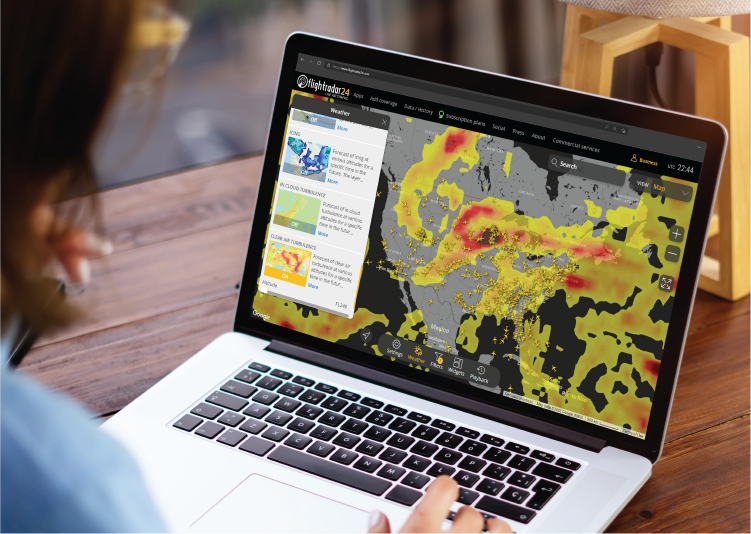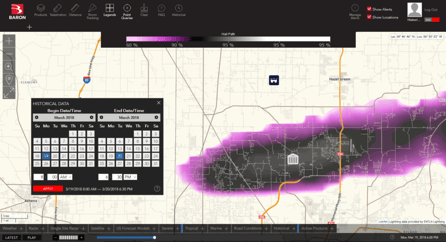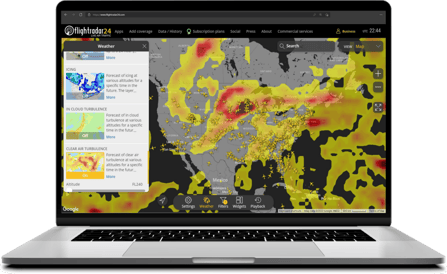People talk about the weather all the time. It's available everywhere: within an app on your phone, in your car, obviously on the news, and even in home HVAC systems. But, when you need to incorporate weather information into your business processes and products or to make critical decisions, how do you get it? A weather data Application Programming Interface - API is the answer.

Regarding weather, there is no easier way to integrate weather information than the weather data API! These APIs are services that act as an intermediary or mechanism between two different and unrelated applications, allowing them to communicate with a set of definitions and protocols.1 Best of all, an API opens you up to a world of weather information spanning current conditions, historical information, forecasts, and predictive conditions for a broad offering of weather risks, hazards, and climate impacts on local, regional, and global scales.
In this blog post, we'll discuss weather data APIs and their various uses and provide tips on how to use them most effectively for your organization. We will also cover the difference between freely available weather API, where you can receive low-value but freely available weather information, versus more sophisticated weather models and information that can provide clarity and aid in better and more informed decision-making. So, read on to learn everything you need to know about weather data APIs.
What Weather Data APIs are Available and Why Would I Need Them?
Many different weather data APIs are available, each with features and capabilities. Some of the most popular weather data APIs include the National Weather Service API, the Dark Sky API, and the Weather Underground API.
Weather APIs help provide quick and easy access to many data products. For example, the Baron Weather API provides developers with access to data products such as:
- The Baron Tornado Index
- Radar data and imagery
- Current and forecast road conditions
- Satellite imagery from around the world
- National Weather Service advisories
- Flash Flood Risk
Some standard features of weather data APIs:
- Everyday temperature and surface analysis data
- Weather event tracking
- Weather condition forecasting
- Humidity
- Wind direction and speed
- Weather alerts and advisories
Weather data APIs typically provide data for current conditions, forecast data, and historical data. They are used by businesses that need to integrate weather information into their business processes for improved operations, risk assessment, and safety. For example, an insurance carrier may use historical, current, and predictive weather information to assess risk in insuring a property or validating a claim. A transportation company may integrate a weather data API into their fleet management solutions to route vehicles around areas affected by severe weather. A flight-tracking firm integrates weather data into its flight planning software for pilots.
Terms to Know
If you plan on using a weather data API, you must be familiar with some essential terms. This section will list some of the most important terms you'll encounter when working with the weather data API. We hope this will help you understand the concepts behind what the weather data API offers so you can make informed decisions when choosing a provider.
Historical Weather Archive

Our API comes with a comprehensive catalog of accurate and location-specific historical weather data, which can be integrated into your platforms. The Weather Archive is a powerful tool for anyone wanting to access historical weather information to understand current and future weather conditions better, prepare a comprehensive plan, or compare models.
AWS
AWS, or Amazon Web Services, is a platform that provides cloud computing services. It lets you use a remote computer to access AWS resources without installing software. You can use AWS to run your website, store your data, run your business, and much more. Baron uses AWS to provide weather data for mission-critical delivery that scales on demand and is reliable and secure.
SDK
An SDK (software development kit) is a collection of tools, documentation, and code that developers can use to build and develop applications or to help them integrate the code into their applications. An SDK can be open-source or proprietary, but the two main types are mobile and desktop.
- Mobile SDKs are designed for developing applications for mobile platforms, such as iOS and Android
- Desktop SDKs are designed to develop desktop applications, such as Windows and Mac.
Mobile Toolkit
The Baron Mobile Toolkit, a series of mobile SDKs, provides easy plug-and-play solutions for adding intelligent weather content to your existing applications.
CDN
A Content Delivery Network (CDN) is a network that helps increase the speed and efficiency of delivering content to users. CDNs are typically used by large organizations to distribute content to a global audience, including website content, application files, and videos. CDNs help to reduce latency and provide faster access times by caching data on their servers. This allows users to load the files faster than when delivered directly from the source.
RESTful architecture
 Baron's Weather API delivers data in standardized formats using a RESTful architecture.
Baron's Weather API delivers data in standardized formats using a RESTful architecture.This architecture is typically used when developing web applications, making creating and managing client-side interactions easier. It advocates using the Representational State Transfer (REST) protocol for distributed systems. It enables a system to handle requests and responses in a format that is easy for clients to understand and use. Clients can make requests using standard HTTP methods, such as GET, POST, and PUT, and the server will respond with the requested data in the same format. The focus is typically on the client (the user agent), not the server.
Open Geospatial Consortium (OGC) Implementation
Open Geospatial Consortium (OGC) is an international non-profit organization that helps develop and standardize best practices for sharing spatial data. Serving data using standard protocols established by the OGC, such as Web Map Service (WMS) for map images, enables users to access maps from any web browser, regardless of their device. The Baron GIS boasts a flexible and powerful mapping engine that can handle various mapping tasks. With this solution, organizations can quickly and easily create high-quality maps of their data.
WMS
Web Map Service (WMS) is a standard protocol created by the OGC to deliver map layers through the internet that can be displayed as map images to end-users. This OpenGIS service also allows images to be defined as transparent so that multiple images can be combined.
Visit https://www.ogc.org/standards/wms for official schemas and other related information.
WFS
WFS or Web Feature Service also follows the standard protocol established by the OGC and provides wind, lightning strikes, and other atmospheric data. WFS layers are easily and often added to other GIS software, like the Baron GIS, to create powerful mapping engines.
ArcGIS
An Esri mapping product, ArcGIS provides licensing for location-based analytics. It allows you to visualize your data better and share it more seamlessly. As an Esri partner, Baron utilizes ArcGIS with our Weather API, allowing your developers to directly integrate all the weather information you need into your existing platforms.
What Makes Weather Data APIs So Accurate?
Are you wondering how accurate the weather data you rely on is? Or maybe you're just looking to increase your weather forecasting accuracy? If so, read on for insights into how weather APIs work and how AI and machine learning are used in weather forecasting to make predictions more accurate.
Better Data Leads to Better Accuracy
When it comes to weather data, accuracy is critical. These days, weather predictions are crucial for everyone, from insurance providers to service companies and public event venues. It's not much about your data type but how it's being used. And multiple sources are essential. The right combination of real-time, historical, and even long-term forecast data can be analyzed and cross-checked from various angles and for numerous purposes.
Most weather data is used for making critical decisions. The answer usually must be a "yes" or "no". It's not a spreadsheet with a bunch of numbers. Baron's API does the number crunching for you. For example, questions that can be quickly answered by deeper data sets are:
1. Is there (or was there) a tornado with this storm?
2. Will (or did) the hail cause damage?
3. Is my business in an area that often floods?
Baron's API also provides weather data, such as rainfall accumulations and wind speed, that can be compared to other reports on the exact location. Historical weather data is also available from the API, which can be analyzed to understand previous weather patterns and compare them to current and future predictions.
How do AI and machine learning help continually make weather forecasts more accurate?
An excellent weather data API relies on a variety of methods, including measuring how often their predictions match up with actual conditions. This allows them to improve their forecasts over time and make them more accurate for users. By using various methods to measure it, they can tailor their content and services to meet the needs of their audience.
Weather forecasts are a vital part of everyday life, and they can sometimes be entirely inaccurate. This is due to several factors, including human error. But thanks to AI and machine learning, weather forecasts are becoming more accurate daily. Analyzing data from satellites, buoys, radar, and other sources enables models to create more precise simulations of the future behavior of weather systems. This then allows for predictions for specific locations to be made with a higher degree of accuracy than ever before. So, whether you're looking for weather updates for your region or just want to be prepared for any eventuality, keep AI and machine learning in mind when making weather forecasts.
How Accurate Can These APIs Get?
Weather data APIs can be inaccurate, resulting in incorrect warnings and decisions about dangerous weather conditions. Hence, the service you use must have the best data possible. Weather data can be very accurate when using strategic combinations of current technologies like:
- Live weather data
- Historical Weather data
- Advanced Modeling
- Climate and Environmental Impacts
What service has the most accurate weather data?
Having accurate weather data is crucial for businesses of all kinds. Whether you're in the Aviation, Insurance, Public safety, or other industries that need accurate weather, you can use many different services. It's essential to consider the number and types of data sources used to know whether your data comes from a handful of broad or specific locations or pinpoint locations across the globe. It's also important to consider if the data is live, historical, or future weather data or a compilation of all three.
A quick Google search can give you options like Foreca or DTN, but Baron Weather provides the most accurate weather data for any service. We help users interpret, analyze, and integrate weather information into their existing systems. This information is sourced from hundreds of data points and includes pin-point accuracy, real-time data, historical data, and advanced data modeling. All of which can be easily integrated and interpreted to fit your needs. Accurate and precise information is critical when lives, property, and businesses are on the line.
What are the Popular Weather APIs?
Many popular weather data APIs are available, including Baron Weather, Accuweather, Yahoo Weather, OpenWeatherMap, and Dark Sky.
Baron Weather
Whether you're an expert in meteorology or a business impacted by weather, we have a solution for you.
Our products help users interpret, analyze, and integrate weather information. Accurate and precise information is critical when lives, property, and businesses are on the line. We simplify the most complex meteorology using the latest machine learning and data science, providing clear, actionable weather intelligence.
Accuweather
Regarding market share, Accuweather is one of the most popular weather data APIs, with a staggering 74% market share.
Weather Underground
This API offers many features, including live streaming and historical data. It is also free to use for up to five requests per day.
OpenWeatherMap
OpenWeatherMap is an easy-to-use platform that is used by millions of people all over the world to access real-time weather data. Using OpenWeatherMap, you can create weather forecasts for your region or even access data from other countries. Additionally, it's highly customizable and can be integrated into your website or app.
Yahoo! Weather
This powerful API offers a wide range of features, including live weather updates, global radar and maps, and detailed local forecasts. Additionally, it provides access to historical weather data to help you make informed business decisions.
Which Weather API is the Best One for Your App?
We might be biased, but Baron Weather is the best, feature-rich API for weather data. It offers real-time data, hourly predictions, historical data, and more.
Some of the other benefits of using Baron Weather include its reliability and fast response time. Additionally, it's easy to use and integrates with many popular programming languages.
Overall, Baron Weather is the perfect choice for any app that needs weather data.
How to Select the Right Weather API for Your Needs
To make the best decision when selecting a weather data API, you must first understand the specific weather threats that pertain to your operation. You need to identify what type of data you need and how you want to receive it. This can include:
- What specific weather threats pertain to your operation?
- What weather data do you need (forecast, historical, local, regional, etc)?
- How does it need to integrate with your application?
For example, suppose you operate a business that relies on shipping weather conditions. In that case, you will need access to real-time weather data to determine traffic congestion and make informed decisions about when and where to dispatch your drivers. You may also want access to historical weather data to correlate precipitation changes with shipping volume changes.
Once you know what kind of data you need and how you want it delivered, the next step is determining which weather data API suits you. There are many different options available, so it's essential that you choose one that meets your needs and expectations.
Baron Weather offers a reliable, scalable API that gives you all of the information you need when you need it. Talk to an expert today to see how our customizable solution can work for you.
